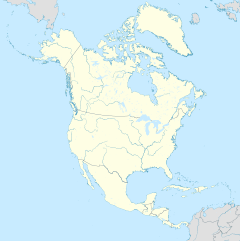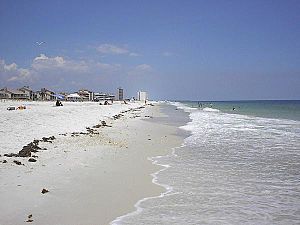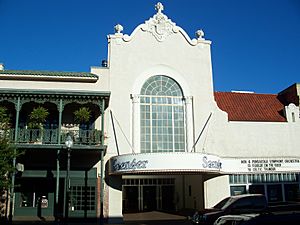Pensacola, Florida facts for kids
Quick facts for kids
Pensacola, Florida
|
||
|---|---|---|
|
City
|
||
| City of Pensacola | ||
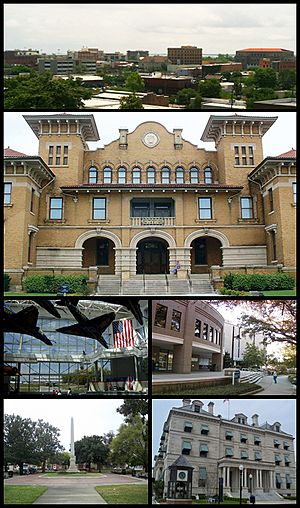
Clockwise from top: Pensacola skyline, Pensacola Museum of History, University of West Florida Library, Escambia County Courthouse, William Dudley Chipley Obelisk, National Naval Aviation Museum
|
||
|
||
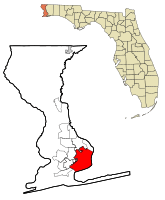
Location in Escambia County and the state of Florida
|
||
| Country | United States | |
| State | Florida | |
| County | Escambia | |
| First settled | 1559 | |
| Resettled | 1667 | |
| Incorporated | 1821 | |
| Founded by | Don Tristan de Luna | |
| Government | ||
| • Type | Mayor–council | |
| • Body | Pensacola City Council | |
| Area | ||
| • City | 41.12 sq mi (106.49 km2) | |
| • Land | 22.76 sq mi (58.95 km2) | |
| • Water | 18.36 sq mi (47.54 km2) | |
| • Metro | 1,669.30 sq mi (4,323.5 km2) | |
| Elevation | 102 ft (31 m) | |
| Population
(2020)
|
||
| • City | 54,312 | |
| • Density | 2,386.19/sq mi (921.30/km2) | |
| • Metro | 497,883 | |
| • Metro density | 1,669.30/sq mi (644.52/km2) | |
| • Demonym | Pensacolian | |
| Time zone | UTC−6 (CST) | |
| • Summer (DST) | UTC−5 (CDT) | |
| ZIP code |
32501, 32512, 32534, 32591, 32502, 32513, 32559, 32592, 32503, 32514, 32573, 32593, 32504, 32516, 32574, 32594, 32505, 32520, 32575, 32595, 32506, 32521, 32576, 32596, 32507, 32522, 32581, 32597, 32508, 32523, 32582, 32598, 32509, 32524, 32589, 32511, 32526, 32590
|
|
| Area code(s) | 850/448 | |
| FIPS code | 12-55925 | |
| GNIS feature ID | 0294117 | |
Pensacola is the westernmost city in the Florida Panhandle, and the county seat and only incorporated city of Escambia County, Florida, United States. As of the 2020 United States census, the population was 54,312. Pensacola is the principal city of the Pensacola Metropolitan Area, which had an estimated 502,629 residents as of 2019[update].
Pensacola is the site of the first Spanish settlement within the borders of the continental United States in 1559, predating the establishment of St. Augustine by 6 years, although the settlement was abandoned due to a hurricane and not re-established until 1698. Pensacola is a seaport on Pensacola Bay, which is protected by the barrier island of Santa Rosa and connects to the Gulf of Mexico. A large United States Naval Air Station, the first in the United States, is located southwest of Pensacola near Warrington; it is the base of the Blue Angels flight demonstration team and the National Naval Aviation Museum. The main campus of the University of West Florida is situated north of the city center.
The area was originally inhabited by Muskogean-speaking peoples. The Pensacola people lived there at the time of European contact, and Creek people frequently visited and traded from present-day southern Alabama and Mississippi and southeast of Louisiana. Spanish explorer Tristán de Luna founded a short-lived settlement in 1559. In 1698 the Spanish established a presidio in the area, from which the modern city gradually developed. The area changed hands several times as European powers competed in North America. During Florida's British rule (1763–1781), fortifications were strengthened.
It is nicknamed "The City of Five Flags", due to the five governments that have ruled it during its history: the flags of Spain (Castile), France, Great Britain, the United States of America, and the Confederate States of America. Other nicknames include "World's Whitest Beaches" (due to the white sand of Florida panhandle beaches), "Cradle of Naval Aviation", "Western Gate to the Sunshine State", "America's First Settlement", "Emerald Coast", "Red Snapper Capital of the World", and "P-Cola".
Contents
History
Spanish Empire 1559–1719, 1722–1763 and 1781–1819
French Empire 1719–1722
British Empire 1763–1781
Confederate States of America 1861–1865
United States of America 1821–1861 and 1865–present
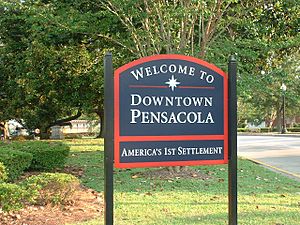
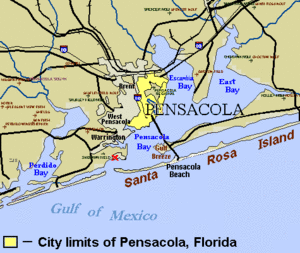
The original inhabitants of the Pensacola Bay area were Native American peoples. At the time of European contact, a Muskogean-speaking tribe known to the Spanish as the Pensacola lived in the region. This name was not recorded until 1677, but the tribe appears to be the source of the name "Pensacola" for the bay and thence the city. Creek people, also Muskogean-speaking, came regularly from present-day southern Alabama to trade, so the peoples were part of a broader regional and even continental network of relations.
The best-known Pensacola culture site in terms of archeology is the Bottle Creek site, a large site located 59 miles (95 km) west of Pensacola north of Mobile, Alabama. This site has at least 18 large earthwork mounds, five of which are arranged around a central plaza. Its main occupation was from 1250 AD to 1550. It was a ceremonial center for the Pensacola people and a gateway to their society. This site would have had easy access by a dugout canoe, the main mode of transportation used by the Pensacola.
The area's written recorded history begins in the 16th century, with documentation by Spanish explorers who were the first Europeans to reach the area. The expeditions of Pánfilo de Narváez in 1528 and Hernando de Soto in 1539 both visited Pensacola Bay, the latter of which documented the name "Bay of Ochuse".
In 1559, Tristán de Luna y Arellano landed with some 1,500 people on 11 ships from Veracruz, Mexico. The expedition was to establish an outpost, ultimately called Santa Maria de Ochuse by Luna, as a base for Spanish efforts to colonize Santa Elena (present-day Parris Island, South Carolina.) But the colony was decimated by a hurricane on September 19, 1559, which killed an unknown number of sailors and colonists, sank six ships, grounded a seventh, and ruined supplies. The survivors struggled to survive, most moving inland to central Alabama for several months in 1560 before returning to the coast, but after two years, the effort was abandoned in 1561. Some of the survivors eventually sailed to Santa Elena (today's Parris Island, South Carolina), but another storm hit there. Survivors made their way to Cuba and finally returned to Pensacola, where the remaining 50 at Pensacola were taken back to Veracruz. The Viceroy's advisers later concluded that northwest Florida was too dangerous to settle. They ignored it for 137 years.
In the late 17th century, the French began exploring the lower Mississippi River with the intention of colonizing the region as part of La Louisiane or New France in North America. Fearful that Spanish territory would be threatened, the Spanish founded a new settlement in western Florida. In 1698 they established a fortified town near what is now Fort Barrancas, laying the foundation for permanent European-dominated settlement of the modern city of Pensacola. The Spanish built three presidios in Pensacola:
- Presidio Santa Maria de Galve (1698–1719): the presidio included fort San Carlos de Austria (east of present Fort Barrancas) and a village with church;
- Presidio Isla de Santa Rosa (1722–1752): this next presidio was on western Santa Rosa Island near the site of present Fort Pickens, but hurricanes battered the island in 1741 and 1752. The garrison was moved to the mainland;
- Presidio San Miguel de Panzacola (1754–1763): the final presidio was built about 5 miles (8 km) east of the first presidio; the present-day historic district of downtown Pensacola, named from "Panzacola", developed around the fort.
During the early years of settlement, a tri-racial creole society developed. As a fortified trading post, the Spanish had mostly men stationed here. Some married or had unions with Pensacola, Creek or African women, both slave and free, and their descendants created a mixed-race population of mestizos and mulattos. The Spanish encouraged slaves from the southern British colonies to come to Florida as a refuge, promising freedom in exchange for conversion to Catholicism and militia service. Most went to the area around St. Augustine, but escaped slaves also reached Pensacola.
After years of settlement, the Spanish ceded Florida to the British in 1763 as a result of an exchange following British victory over France in the French and Indian War (the North American theater of the Seven Years' War), and French cession of its territories in North America. The British designated Pensacola as the capital of their new colony of West Florida. From 1763, the British strengthened defenses around the mainland area of fort San Carlos de Barrancas, building the Royal Navy Redoubt.
After Spain joined the American Revolution in 1779 on the side of the rebels, Spanish forces captured the city in the 1781 Battle of Pensacola, gaining control of West Florida. After the war, the British officially ceded both West Florida and East Florida to Spain.
In 1785 with the founding of the Panton, Leslie Company here, many Creek from southern Alabama and Georgia came to trade, and it developed as a major center. It was a garrison town, predominantly males in the military or trade. Americans made raids into the area, and settlers pressured the federal government to gain control of this territory.
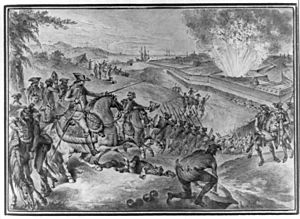
In 1819 Spain and the United States negotiated the Adams–Onís Treaty, by which Spain sold the Floridas to the United States for US$5 million. A Spanish census of 1820 indicated 181 households in the town, with a third of mixed-blood. The people were predominantly French and Spanish Creole. Indians in the area were noted through records, travelers' accounts, and paintings of the era, including some by George Washington Sully and George Catlin. Creek women were also recorded in marriages to Spanish men, in court records or deeds.
In 1821, with Andrew Jackson as provisional governor, Pensacola became part of the United States. The Creek continued to interact with European Americans and African Americans, but the dominant whites increasingly imposed their binary racial classifications: white and black ("colored", within which were included free people of color, including Indians). However, American Indians and mestizos were identified separately in court and Catholic church records, and as Indians in censuses up until 1840, attesting to their presence in the society. After that, the Creek were not separately identified as Indian, but the people did not disappear. Even after removal of many Seminole to Indian Territory, Indians, often of mixed-race but culturally identifying as Muskogean, lived throughout Florida.
St. Michael's Cemetery was established in the 18th century at a location in a south central part of the city, which developed as the Downtown area. Initially owned by the Church of St. Michael, it is now owned and managed by St. Michael's Cemetery Foundation of Pensacola, Inc. Preliminary studies indicate that there are over 3,200 marked burials as well as a large number unmarked.
Tensions between the white community and Indians tended to increase during the Removal era. In addition, an increasing proportion of Anglo-Americans, who constituted the majority of whites by 1840, led to a hardening of racial discrimination in the area. There was disapproval of white men living with women of color, which had previously been accepted. In 1853 the legislature passed a bill prohibiting Indians from living in the state, and provided for capture and removal to Indian Territory.
While the bill excluded half-bloods and Indians already living in white communities, they went "underground" to escape persecution. No Indians were listed in late 19th and early 20th century censuses for Escambia County. People of Indian descent were forced into the white or black communities by appearance, and officially, in terms of records, "disappeared". It was a pattern repeated in many Southern settlements. Children of white fathers and Indian mothers were not designated as Indian in the late 19th century, whereas children of blacks or mulattos were classified within the black community, related to laws during the slavery years.
In 1907–1908 there were 116 Creek in Pensacola who applied for the Eastern Cherokee enrollment, thinking that all Indians were eligible to enroll. Based on Alabama census records, most of these individuals have been found to be descendants of Creek who had migrated to the Pensacola area from southern Alabama after Indian removal of the 1830 s.
Geography
Topography
Pensacola is located at 30°26′13″N 87°12′33″W / 30.43694°N 87.20917°W (30.436988, −87.209277), on the north side of Pensacola Bay. It is 59 miles (95 km) east of Mobile, Alabama, and 196 miles (315 km) west of Tallahassee, the capital of Florida. According to the United States Census Bureau, Pensacola has a total area of 40.7 square miles (105.4 km2), consisting of 22.5 square miles (58.4 km2) of land and 18.1 square miles (47.0 km2), 44.62%, water.
Architecture
Pensacola does not have a prominent skyline, but has several low-rise buildings. The tallest is the 15-floor Crowne Plaza Grand Hotel, which stands at 146 feet (45 m). Other tall buildings include the Scenic Apartments (98 feet (30 m)), SunTrust Tower (96 feet (29 m)), Seville Tower (88 feet (27 m)), and the AT&T Building (76 feet (23 m)).
Historic buildings in Pensacola include the First National Bank Building.
Climate
Cantonment Clinch, a short-lived United States Army outpost, began providing meteorological observations in the 1820s through the 1830s. Observations from the Pensacola area by other sources continued intermittently over the next several decades.
Weather statistics since the late 20th century have been recorded at the airport. The city has seen single digit temperatures (below −12 °C) on three occasions: 5 °F (−15 °C) on January 21, 1985, 7 °F (−14 °C) on February 13, 1899 and 8 °F (−13 °C) on January 11, 1982. According to the Köppen Climate Classification system, Pensacola has a humid subtropical climate, (Köppen Cfa), with short, mild winters and hot, humid summers. Typical summer conditions have highs in the lower 90s °F (32–34 °C) and lows in the mid 70s °F (23–24 °C). Afternoon or evening thunderstorms are common during the summer months. Due partly to the coastal location, temperatures above 100 °F (38 °C) are relatively rare, and last occurred in June 2011, when two of the first four days of the month recorded highs reaching the century mark. The highest temperature ever recorded in the city was 106 °F (41 °C) on July 14, 1980. The daily average temperature in January is 51.4 °F (10.8 °C); freezing temperatures occur on an average 13.7 nights per season, with the average window for freezing conditions being from December 13 to February 20. Temperatures below 20 °F (−7 °C) are very rare, and last occurred on January 8, 2015, when a low of 19 °F (−7 °C) was seen. The lowest temperature ever recorded in the city was 5 °F (−15 °C) on January 21, 1985.
Snow is rare in Pensacola, but does occasionally fall. The most recent snow event occurred on February 12, 2010. The city receives 64.28 inches (1,630 mm) of precipitation per year, with a rainy season in the summer. The rainiest month is July, with 7.40 inches (188 mm), with May being the driest month at 4.17 inches (106 mm). In June 2012 over one foot (300 mm) of rain fell on Pensacola and adjacent areas, leading to widespread flooding. On April 29, 2014. Pensacola was drenched by at least 20 inches of rain within a 24-hour period, causing the worst flooding in 30 years
The city suffered a major blow on February 23, 2016, when a large EF3 wedge tornado hit the northwest part of Pensacola, causing major damage and several injuries.
| Climate data for Pensacola, Florida (Pensacola Int'l), 1981–2010 normals | |||||||||||||
|---|---|---|---|---|---|---|---|---|---|---|---|---|---|
| Month | Jan | Feb | Mar | Apr | May | Jun | Jul | Aug | Sep | Oct | Nov | Dec | Year |
| Record high °F (°C) | 81 (27) |
82 (28) |
88 (31) |
96 (36) |
102 (39) |
102 (39) |
106 (41) |
104 (40) |
102 (39) |
95 (35) |
87 (31) |
81 (27) |
106 (41) |
| Average high °F (°C) | 60.5 (15.8) |
63.8 (17.7) |
69.6 (20.9) |
75.7 (24.3) |
83.2 (28.4) |
88.5 (31.4) |
90.0 (32.2) |
89.4 (31.9) |
86.5 (30.3) |
78.9 (26.1) |
70.3 (21.3) |
62.6 (17.0) |
76.6 (24.8) |
| Average low °F (°C) | 42.2 (5.7) |
45.5 (7.5) |
51.2 (10.7) |
57.6 (14.2) |
66.0 (18.9) |
72.5 (22.5) |
74.5 (23.6) |
74.2 (23.4) |
70.3 (21.3) |
60.3 (15.7) |
51.2 (10.7) |
44.4 (6.9) |
59.2 (15.1) |
| Record low °F (°C) | 5 (−15) |
7 (−14) |
22 (−6) |
33 (1) |
44 (7) |
55 (13) |
61 (16) |
60 (16) |
43 (6) |
32 (0) |
22 (−6) |
11 (−12) |
5 (−15) |
| Average precipitation inches (mm) | 4.64 (118) |
5.06 (129) |
5.81 (148) |
4.32 (110) |
4.17 (106) |
6.60 (168) |
7.40 (188) |
6.77 (172) |
5.98 (152) |
5.24 (133) |
4.73 (120) |
4.55 (116) |
65.27 (1,658) |
| Average precipitation days (≥ 0.01 in) | 8.9 | 8.6 | 8.1 | 6.5 | 6.7 | 11.1 | 14.0 | 13.6 | 8.8 | 6.1 | 7.2 | 9.0 | 108.6 |
| Source: NOAA (extremes 1879–present) | |||||||||||||
Hurricanes

Pensacola's location on the Florida Panhandle makes it vulnerable to hurricanes. Major hurricanes which have made landfall at or near Pensacola since the late 20th century include Eloise (1975), Frederic (1979), Juan (1985), Erin (1995), Opal (1995), Georges (1998), Ivan (2004), and Dennis (2005).
Pensacola and several surrounding areas were devastated by Hurricane Ivan. Pensacola was on the eastern side of the eyewall, which sent a large storm surge into Escambia Bay; this destroyed most of the I-10 Escambia Bay Bridge. The storm knocked 58 spans off the eastbound and westbound bridges and misaligned another 66 spans, forcing the bridge to close to traffic in both directions. The surge also destroyed the fishing bridge that spanned Pensacola Bay alongside the Phillip Beale Memorial Bridge, locally known as the Three Mile Bridge.
Over $6 billion in damage occurred in the metro area and more than 10,000 homes were destroyed, with another 27,000 heavily damaged. NASA created a comparison image to illustrate the massive damage. Because of the widespread losses, Hurricane Ivan drove up the cost of housing in the area, leading to a severe shortage of affordable housing. In July 2005, Hurricane Dennis made landfall just east of the city, sparing it the damage received from Ivan the year before. However, hurricane and near-hurricane-force winds were recorded in downtown, causing moderate damage.
Pensacola received only a glancing blow from Hurricane Katrina in 2005, resulting in light to moderate damage reported in the area. The aftermath of the extensive damage from Katrina was a dramatic reduction in tourism coming from Louisiana, Mississippi and Alabama.
Demographics
| Historical population | |||
|---|---|---|---|
| Census | Pop. | %± | |
| 1850 | 2,164 | — | |
| 1860 | 2,876 | 32.9% | |
| 1870 | 3,347 | 16.4% | |
| 1880 | 6,845 | 104.5% | |
| 1890 | 11,750 | 71.7% | |
| 1900 | 17,747 | 51.0% | |
| 1910 | 22,982 | 29.5% | |
| 1920 | 31,035 | 35.0% | |
| 1930 | 31,579 | 1.8% | |
| 1940 | 37,449 | 18.6% | |
| 1950 | 43,479 | 16.1% | |
| 1960 | 56,752 | 30.5% | |
| 1970 | 59,507 | 4.9% | |
| 1980 | 57,619 | −3.2% | |
| 1990 | 58,165 | 0.9% | |
| 2000 | 56,255 | −3.3% | |
| 2010 | 51,923 | −7.7% | |
| 2020 | 54,312 | 4.6% | |
| U.S. Decennial Census | |||
As of the census of 2010, there were 51,923 people, 23,600 households, and 14,665 families residing in the city, and 402,000 people in the Pensacola MSA. The population density was 2,303.5 people per square mile (956.8/km2). There were 26,848 housing units at an average density of 1,189.4 per square mile (459.2/km2). The racial makeup of the city was 66.3% White, 28.0% African American, 2.0% Asian, 0.6% Native American, 0.1% Pacific Islander, 2.3% from two or more races. 3.3% were Hispanic or Latino of any race.
There were 24,524 households, out of which 24.6% had children living with them, 39.7% were married couples living together, 16.7% had a female householder with no husband present, and 40.2% were non-families. 32.9% of all households were made up of individuals, and 11.7% had someone living alone who was 65 years of age or older. The average household size was 2.27 and the average family size was 2.92.
Out of the total population in Pensacola, 45.9% identified with a religion, slightly lower than the national average of 48.3%. Over 48% of Pensacolians who practice a religion identify as Baptists (22.1% of all city residents). Other Christian denominations include Roman Catholics (9.2% of city residents), Pentecostal (3.8%), Methodist (3.8%), Episcopal (1.1%), Presbyterian (1.1%), and Orthodox (0.3%).
Pensacola is home to a small (0.2% of city residents) but significant Jewish community, whose roots date mostly to German Jewish immigrants of the mid-to-late 19th century. There were also Sephardic Jewish migrants from other areas of the South, and immigrants from other areas of Europe. The first Florida chapter of B'nai Brith was founded downtown in 1874, as well as the first temple, Beth-El, in 1876. Apart from the Reform Beth-El, Pensacola is also served by the Conservative B'nai Israel Synagogue. Paula Ackerman, the first woman who performed rabbinical functions in the United States, was a Pensacola native and led services at Beth-El.
The median income for a household in the city was $34,779, and the median income for a family was $42,868. Males had a median income of $32,258 versus $23,582 for females. The per capita income for the city was $30,556 in 2011. About 12.7% of families and 16.3% of the population were below the poverty line, including 26.2% of those under age 18 and 9.2% of those age 65 or over.
Culture
The arts and theatre
There are a number of different performance venues in the Pensacola Area, including the Pensacola Bay Center (formerly the Pensacola Civic Center), often used for big ticket events, and the Saenger Theater, used for performances and mid-level events. Other theatres used for live performances, plays, and musicals include the Pensacola Little Theatre, Pensacola State College, University of West Florida, Vinyl Music Hall, and Loblolly Theatre. Pensacola is also home to the Pensacola Opera, Pensacola Children's Chorus, Pensacola Symphony Orchestra, and the Choral Society of Pensacola, as well as Ballet Pensacola. There is also the Palafox Place entertainment district.
Parks and recreation
- Big Lagoon State Park
- Perdido Key State Park
- Tarkiln Bayou Preserve State Park
- Pensacola Bayfront Stadium
- Plaza Ferdinand VII
Sister cities
According to Sister City International, Pensacola has the following sister cities:
 Isla Mujeres, Quintana Roo, Mexico
Isla Mujeres, Quintana Roo, Mexico Chimbote, Peru
Chimbote, Peru Escazu, Costa Rica
Escazu, Costa Rica Gero, Japan
Gero, Japan Horlivka, Ukraine
Horlivka, Ukraine Miraflores, Peru
Miraflores, Peru Kaohsiung, Taiwan
Kaohsiung, Taiwan Macharaviaya, Málaga, Andalusia, Spain
Macharaviaya, Málaga, Andalusia, Spain
Economy
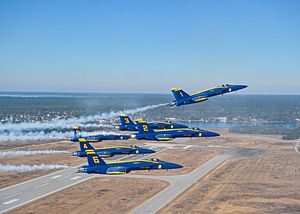
Military
The city has been referred to as "The Cradle of Naval Aviation". Naval Air Station Pensacola (NASP) was the first Naval Air Station commissioned by the U.S. Navy in 1914. Tens of thousands naval aviators have received their training there, including John H. Glenn, USMC, who became the first American to orbit the earth in 1962, and Neil Armstrong, who became the first man to set foot on the moon in 1969. The Navy's Flight Demonstration Squadron, the Blue Angels, is stationed there.
The National Museum of Naval Aviation is located on the Naval Air Station and is free to the public. The museum cares for and exhibits hundreds of vintage Naval Aviation aircraft and preserves the history of Naval Aviation through displays, symposiums, IMAX movies and tours.
Corry Station Naval Technical Training Center serves as an annex for the main base and the center for Information Dominance. CWO3 Gary R. Schuetz Memorial Health Clinic is at Corry Station, Naval Hospital Pensacola, as is the main Navy Exchange and Defense Commissary Agency commissary complex for both Corry Station and NAS Pensacola. The Army National Guard B Troop 1-153 Cavalry, Bravo Company 146th Expeditionary Signal Battalion is stationed in Pensacola.
Tourism
Pensacola is home to a number of annual festivals, events, historic tours, and landmarks. The Pensacola Seafood Festival and the Pensacola Crawfish Festival have been held for nearly 30 years in the city's historic downtown. The Great Gulfcoast Arts Festival is held annually in November in Seville Square, and often draws more than 200 regional and international artists. The Children's Art Festival, also held in Seville Square, displays art by local schoolchildren. Pensacon is a comic convention held each February, with nearly 25,000 attendees from around the world.
Scuba diving and deep sea fishing are a large part of Pensacola's tourism industry. The USS Oriskany was purposefully sunk in 2004 to create an artificial reef off the shores of Pensacola.
There are several walking tours of restored 18th-century-era neighborhoods in Pensacola.
Pensacola is the site of the Vietnam Veterans' Wall South. There are a number of historical military installations from the Civil War, including Fort Barrancas. Fort Pickens served as a temporary prison for Geronimo. Other military landmarks include the National Naval Aviation Museum and Pensacola Lighthouse at NAS Pensacola.
The city's convention and visitors' bureau, Visit Pensacola, is overseen by the Greater Pensacola Chamber.
Top employers
| Rank | Employer | Employees |
|---|---|---|
| 1 | Navy Federal Credit Union | 7,723 |
| 2 | Baptist Health Care | 6,633 |
| 3 | Sacred Heart Health Systems | 4,820 |
| 4 | Gulf Power Company | 1,774 |
| 5 | West Florida Healthcare | 1,200 |
| 6 | Ascend Performance Materials | 888 |
| 7 | Alorica (fka West Corporation) | 800 |
| 8 | Innisfree Hotels | 750 |
| 9 | Santa Rosa Medical Center | 521 |
| 10 | Medical Center Clinic | 500 |
Sports
| Team | Sport | League | Venue |
| Pensacola Ice Flyers | Ice hockey | Southern Professional Hockey League | Pensacola Bay Center |
| Gulf Coast Riptide | American football | Women's Spring Football League | Escambia High School |
| Pensacola Blue Wahoos | Baseball | Southern League (AA) | Pensacola Bayfront Stadium |
| Pensacola FC | Soccer | Gulf Coast Premier League | Ashton Brosnaham Stadium |
| West Florida Argonauts | Baseball, Basketball, American Football | NCAA Division II Gulf South Conference | University of West Florida |
| Pensacola Roller Gurlz | Flat Track Roller Derby | Women's Flat Track Derby Association | Dreamland Skate Center |
Pensacola Marathon
The Pensacola Marathon is hosted annually on Veteran's Day weekend. The race begins and ends at Admiral Mason Park running 26.2 miles through several Pensacola neighborhoods.
Education
The main campus of Pensacola State College is in the City of Pensacola. The University of West Florida (UWF) operates a campus in downtown Pensacola. Its main campus, located north of the city, has the largest library in the region, the John C. Pace Library. UWF is the largest post-secondary institution in the area.
Public primary and secondary schools in Pensacola are administered by the Escambia County School District. The district operates two high schools (Booker T. Washington and Pensacola) within the City of Pensacola. District-run high schools near the city include Escambia, J. M. Tate, and Pine Forest. Other public schools in the city include A.K. Suter Elementary, Cordova Park Elementary, J.H. Workman Middle, N.B. Cook Elementary, O.J. Semmes Elementary, and Scenic Heights Elementary. The district also operates one magnet high school (West Florida High School of Advanced Technology) near the city.
Several private schools operate within or near the city: East Hill Academy, East Hill Christian School, Episcopal Day School of Christ Church, Pensacola Catholic High School, Pensacola Christian Academy, Sacred Heart Cathedral School, Saint John the Evangelist Catholic School, Saint Paul Catholic School, Little Flower Catholic School, and Seville Bayside Montessori. The campus of Pensacola Christian College is near the city.
Infrastructure
Transportation
Aviation
Major air traffic in the Pensacola and greater northwest Florida area is handled by Pensacola International Airport. As of November 2019[update], airlines serving Pensacola International Airport are American Airlines, Delta Air Lines, Frontier Airlines, Silver Airways, Southwest Airlines, Boutique Airlines, Spirit Airlines, and United Airlines.
Railroads
Pensacola was first connected by rail with Montgomery, Alabama, via the Alabama and Florida Railroad, completed in 1861 just before the start of the Civil War. During the war, most of the rails between Pensacola and the Alabama state line were removed to construct other railroad lines urgently needed elsewhere in the Confederacy. The line to Pensacola was not rebuilt until 1868, and was acquired by the Louisville and Nashville Railroad in 1880. In 1882, the Pensacola and Atlantic Railroad was completed from Pensacola to Chattahoochee, Florida, linking Pensacola with the rest of the state. This line was also acquired by the L&N.
By 1928, a number of short lines built northward from Pensacola to Kimbrough, Alabama, were acquired by the Frisco Railroad, giving it access to the port of Pensacola. Some thirty years later, retired Frisco steam engine 1355 was donated to the city and stands in the median of Garden Street, near the site of the now-demolished Frisco passenger station.
Frisco passenger service to Pensacola ended in 1955, and L&N passenger service, including the streamlined Gulf Wind, ended in 1971 with the advent of Amtrak. However, from early 1993 through August 2005 Pensacola was served by the tri-weekly Amtrak Sunset Limited, but service east of New Orleans to Jacksonville and Orlando was suspended due to damage to the rail line of CSX during Hurricane Katrina in 2005.
In the 21st century, freight service to and from Pensacola is provided by L&N successor CSX as well as Frisco successor Alabama and Gulf Coast Railway, a short line. On June 1, 2019, the newly formed Florida Gulf & Atlantic Railroad, a Class III railroad headquartered in Tallahassee, acquired the CSX main line from Pensacola to Baldwin, Florida, near Jacksonville, becoming the Panhandle's only east–west freight hauler. A news report on the new railroad in mid-2019 noted that Amtrak indicated that the Panhandle had a "near-zero chance" of seeing passenger service restored. Pensacola and Tallahassee are the two largest metropolitan areas in Florida without any passenger rail service.
Major highways
 Interstate 10
Interstate 10 Interstate 110
Interstate 110 U.S. Route 29
U.S. Route 29 U.S. Route 90 & U.S. Route 90 Alternate
U.S. Route 90 & U.S. Route 90 Alternate U.S. Route 98 & U.S. Route 98 Business
U.S. Route 98 & U.S. Route 98 Business State Road 289 Ninth Avenue
State Road 289 Ninth Avenue State Road 290 Olive Road
State Road 290 Olive Road State Road 291 Davis Highway
State Road 291 Davis Highway State Road 292 Pace Boulevard
State Road 292 Pace Boulevard State Road 295 New Warrington Road, Farfield Drive
State Road 295 New Warrington Road, Farfield Drive State Road 296 Michigan Avenue, Beverly Parkway, Brent Lane, Bayou Boulevard, Perry Street
State Road 296 Michigan Avenue, Beverly Parkway, Brent Lane, Bayou Boulevard, Perry Street State Road 742 Creighton Road, Burgess Road
State Road 742 Creighton Road, Burgess Road State Road 750 Airport Boulevard
State Road 750 Airport Boulevard
Mass transit
The local bus service is the Escambia County Area Transit. In December 2007, ECAT announced that it would cut many of its routes citing poor rider frequency. However, in January 2008, ECAT announced that it would expand service to neighboring Gulf Breeze and change existing routes to more convenient locations.
Bus
The city is served by Greyhound Bus and Greyhound Lines.
Hospitals
Hospitals in Pensacola include Ascension Sacred Heart Hospital, Baptist Hospital, Encompass Health Rehabilitation Hospital, HCA Florida West Hospital, Select Specialty Hospital, and West Florida Hospital.
Notable people
- Chuck Baldwin, politician, pastor
- Derrick Brooks, Hall of Fame NFL linebacker
- Ashley Brown, singer and actress
- Austin Carlile, lead vocalist for Of Mice & Men
- Adron Chambers, baseball player, 2011 World Series champion
- Josh Donaldson, Major League Baseball third baseman for the Minnesota Twins
- Reggie Evans, NBA player
- Samuel Gibbs French, Confederate Major General
- Derrick Gainer, former world champion boxer
- Mark Gormley, singer-songwriter who rose to internet fame
- Gigi Gryce, jazz composer and musician
- Harry B. Harris Jr., first Asian-American four-star admiral in the U.S. Navy; U.S. Pacific Command Commanding Officer.
- Kim Helton, college and pro football coach
- Martin Holley, Roman Catholic bishop
- Kent Hovind, Christian fundamentalist evangelist and tax protester
- Daniel "Chappie" James Jr., former US Air Force fighter pilot who became the first African American to reach the rank of four-star general in the military
- Horace Jones, NFL defensive end
- Roy Jones, Jr., professional boxing champion and 1988 Olympic silver medalist
- Phil Thomas Katt, singer-songwriter, filmmaker, music video producer, and radio DJ. Host of The Uncharted Zone
- Fred Levin, attorney from Pensacola, co-founder of the Levin Papantonio Law Firm
- Max Macon, Major League Baseball pitcher/first baseman-outfielder and scout, Minor League manager, high school and college basketball referee
- Rob Mariano, Survivor Hall of Fame member, Amazing Race contestant and winner of Survivor Redemption Island
- Amber Mariano, Survivor castaway, Amazing Race contestant and winner of Survivor All-Stars
- Gwen McCrae, singer
- Mike McCready, lead guitar player for Pearl Jam
- Katy Mixon, actress
- Alfred Morris, NFL running back
- Joan Perry, actress
- Jeremy Reaves, NFL strong safety
- Roman Reigns, professional wrestler currently signed to WWE
- Trent Richardson, NFL running back
- Fred Robbins, NFL defensive tackle
- Peter S. Ruckman, pastor
- Buck Showalter, former manager Major League Baseball
- John Schwab, actor
- Don Shirley, famed pianist, focus of the movie Green Book
- Josh Sitton, NFL offensive lineman
- Betty Skelton, aviatrix and auto racer
- Emmitt Smith, NFL running back in Pro Football Hall of Fame
- Peter Thomas, narrator known for Forensic Files
- Rysa Walker, author of The Chronos Files series
- Jim White, singer, songwriter and guitarist
- Holman Williams, boxer in International Boxing Hall of Fame
See also
 In Spanish: Pensacola para niños
In Spanish: Pensacola para niños





